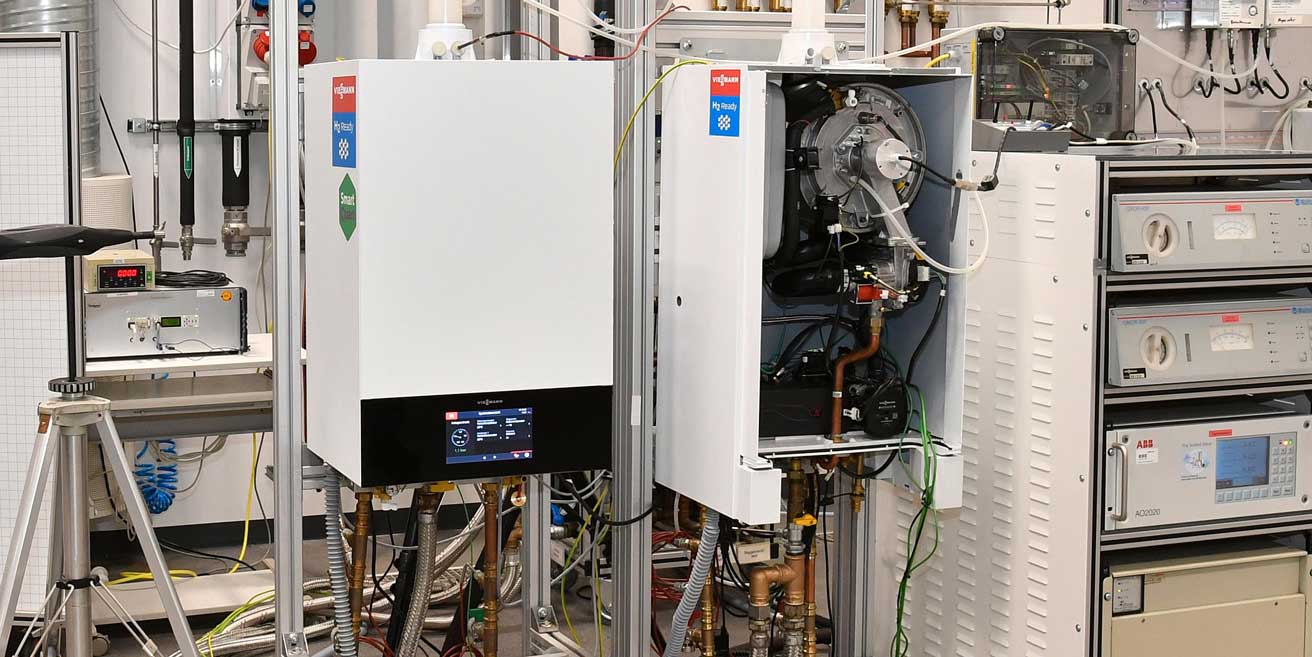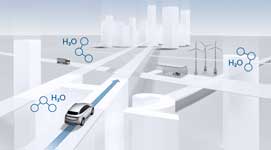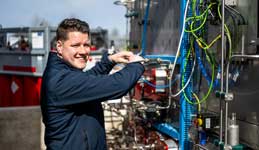Hydrogen heating as a contribution to a climate-neutral future
- Details
- Hits: 12878
The heat sector is very suitable for the installation of an environmentally friendly Hydrogen heating. Even today, 20% hydrogen can be mixed with natural gas and thus with CO2 Significantly reduce emissions. Viessmann is already developing a complete product range for hydrogen heating and is also testing the hydrogen-compatible fuel cell heating.

Contents
- Heating sector with hydrogen as an energy carrier
- Strategies for the hydrogen infrastructure
- Why hydrogen?
Until 2050 become climate neutral and the CO2-Reducing emissions to zero are the goals of German and European politics. To achieve this, the burning of fossil fuels must be replaced with environmentally friendly solutions. In the heating sector, there will be a mix of electricity-based solutions such as heat pumps and renewable energy sources such as synthetic methane and hydrogen CO2-Neutral generated with the fuel cell. Hydrogen in particular will play a central role in heating. Its use is the consistent way to make the heating market climate neutral.
Heating sector with hydrogen as an energy carrier
Hydrogen heating is a partner in electrification. The hydrogen helps reduce the investment for that CO2-free heating in Buildings to realize. A leading study by the German Energy Agency (Dena) shows that a mix of electricity and hydrogen heating in buildings would reduce energy system costs by at least 260 billion euros by 2050.
Use gas infrastructure for hydrogen heating

The expansion of reserve power plants and power grids, which in the complete Electrification of the heating sector required would be significantly lower if the existing gas infrastructure were used for hydrogen.
 Gateways | The bridge to the Industry 4.0 factory
Gateways | The bridge to the Industry 4.0 factory
In addition, with the new energy carrier hydrogen, the CO2- Significantly reduce emissions. Already today could 20% hydrogen be mixed with natural gas in the network. That would reduce greenhouse gases by around 7% per year - a quick and effective contribution to climate protection.
Modern condensing system with up to 30% hydrogen
The technology is in place for such Natural gas-hydrogen mixtures to be able to use it for building heating. There are thousands of them on the market. The Vitodens 300 and Vitodens 200 gas condensing boilers from Viessmann can in principle already be operated with 20 to 30 percent hydrogen. House and apartment owners are therefore well equipped when they decide to install modern wall-mounted and compact devices.
Strategies for the hydrogen infrastructure
National and international initiatives will drive the expansion of the infrastructure for generating hydrogen in the future. The federal government will have its in summer 2020 national infrastructure presented. She announced funding of 9 billion euros for funding for the targeted further development of the hydrogen infrastructure. At the same time, the EU Commission published a hydrogen strategy to expand production capacities. By 2024, the hydrogen, with Renewable energies produced, rise to up to 1 million t, and then to 2030 million t by 10.
 Seven good reasons for hydrogen propulsion and fuel cells
Seven good reasons for hydrogen propulsion and fuel cells
Today there are already numerous Pilot projects supported. Just recently, in January 2021, the Federal Research Minister (BMBF) three lead projects which resulted from an ideas competition and received funding of EUR 700 million.
The establishment of a Hydrogen infrastructure Another project is funded by the BMWi in Kaisersesch in Rhineland-Palatinate. Under the title “Smartquart”, a complete hydrogen infrastructure will be created by 2023, from the generation of renewable electricity to the operation of the electrolysers for the electrolysis of hydrogen, its storage and distribution to its use in the heating and power supply, industry and transport sectors.
Viessmann has also been involved in this first real laboratory for the energy transition right from the start and, in addition to condensing boilers for hydrogen heating, will also be a hydrogen-compatible one Fuel cell heating try it out in practice.
Condensing boilers for 100% hydrogen
 “We design living spaces for future generations” is Viessmann's concern. For safe, reliable, affordable and climate-neutral heat supply of the future, a team of engineers and technicians in the Viessmann Research and Development Center in Allendorf (Eder) is currently testing H2 ready condensing boilers for operation with pure hydrogen.
“We design living spaces for future generations” is Viessmann's concern. For safe, reliable, affordable and climate-neutral heat supply of the future, a team of engineers and technicians in the Viessmann Research and Development Center in Allendorf (Eder) is currently testing H2 ready condensing boilers for operation with pure hydrogen.
The basis for this are modern, gas-adaptive wall-mounted units for natural gas with a fully premixing surface gas burner. The combustion properties of hydrogen, which differ significantly from gas, require the new development of the system for combustion, flame monitoring and control. It is also necessary to adapt the burner components.
 IO module secures Resato hydrogen filling stations
IO module secures Resato hydrogen filling stations
After Prototype testing The phases of qualification, endurance testing and use of the devices will follow in Kaisersesch from the beginning of 2023. The devices are then expected to be launched on the market from 2024. In Germany there will then be further regional gas networks for the distribution of pure hydrogen to consumers. Incidentally, the H2 ready condensing boilers can be switched from operation with natural gas or a natural gas / hydrogen mixture to operation with pure hydrogen in just a few steps.
But that's not all. Viessmann is currently developing more Condensing systems also for larger capacities as well as fuel cells and combined heat and power plants for the use of hydrogen.
General technical knowledge
Hydrogen can CO2-Neutral generated and burned and is therefore absolutely climate-friendly. The most common element in the universe is not toxic, corrosive, or radioactive. It does not pollute the water or cause environmental damage. With 33,3 kWh / kg, hydrogen has the highest energy density per kg compared to heating oil 11,4 kWh / kg and natural gas 13,9 kWh / kg.
 Reading tip: Measurement technology for hydrogen production
Reading tip: Measurement technology for hydrogen production
However, hydrogen differs significantly from natural gas, for example, in its combustion-relevant properties. The volume related energy density for gaseous hydrogen under normal pressure at normal temperatures is only approx. 3,0 kWh / m³. For natural gas, on the other hand, this is 9,97 kWh / m³.
The hydrogen occurring on earth is practically only present in chemically bound form, for example in the form of water with its oxygen content. Water covers more than two thirds of the earth's surface. The total occurrence of water on earth amounts to about 1,386 billion km³. In addition, natural gases such as methane and petroleum are important hydrogen-containing compounds.
